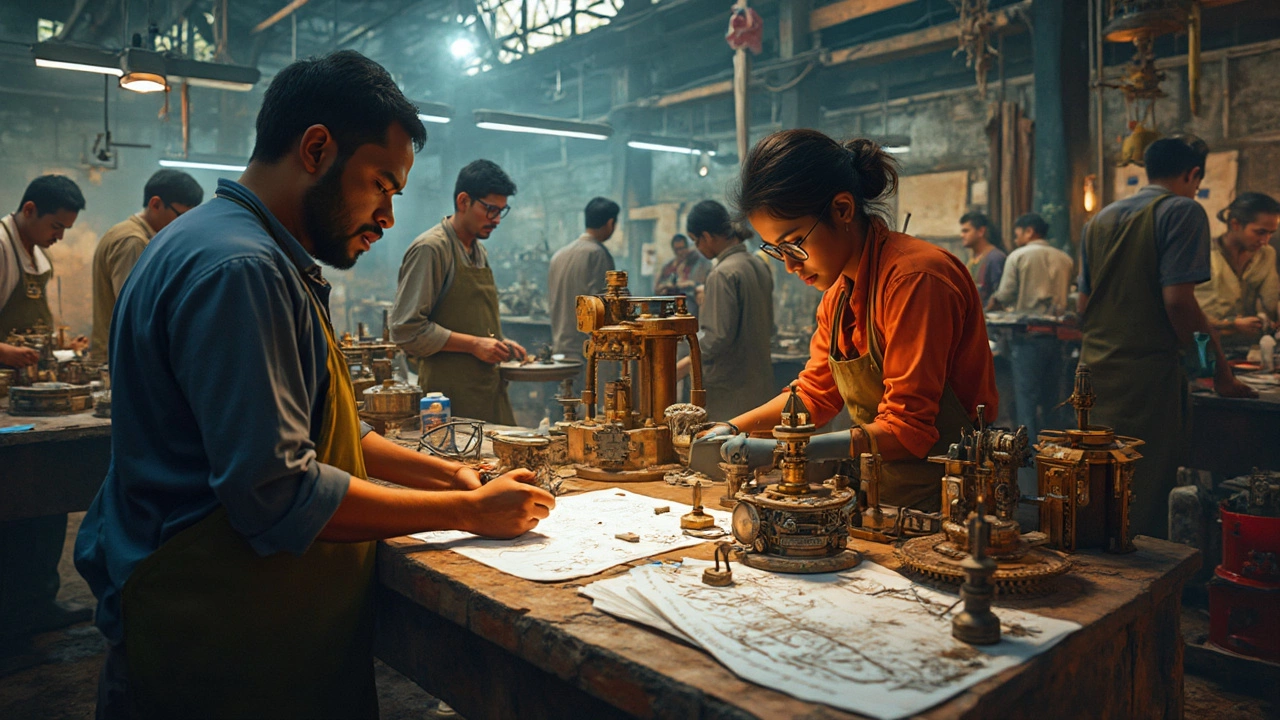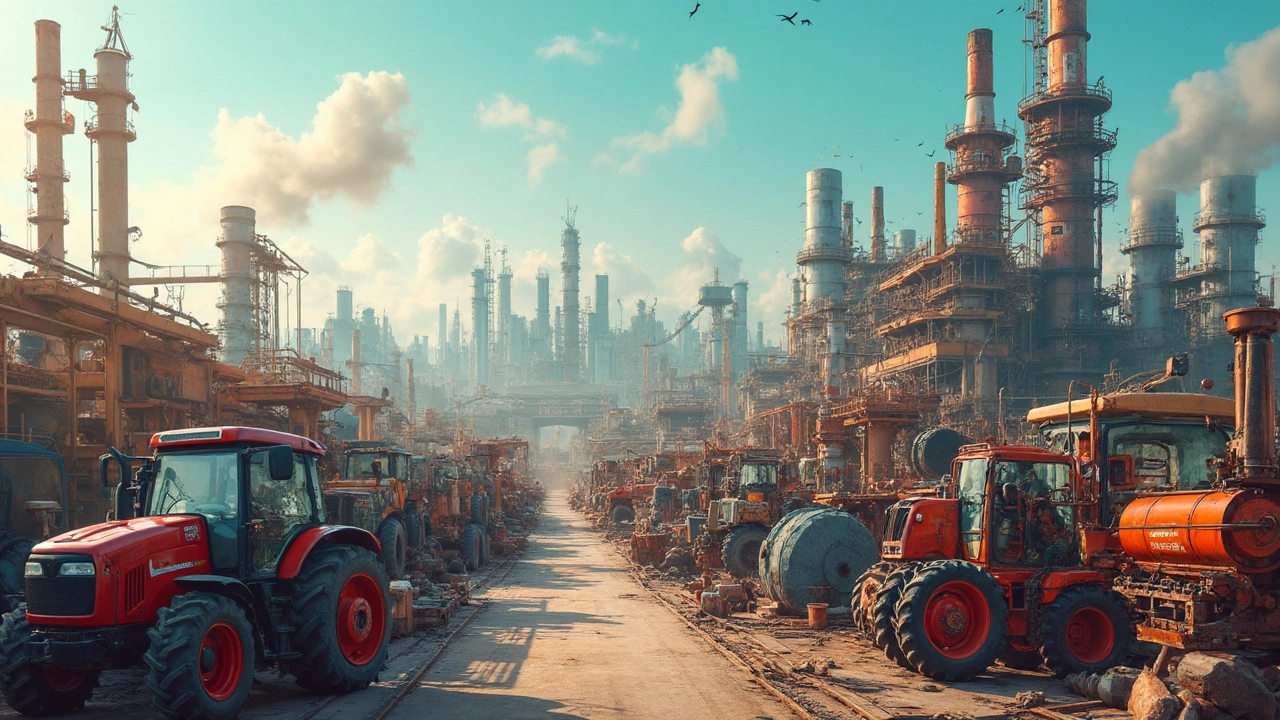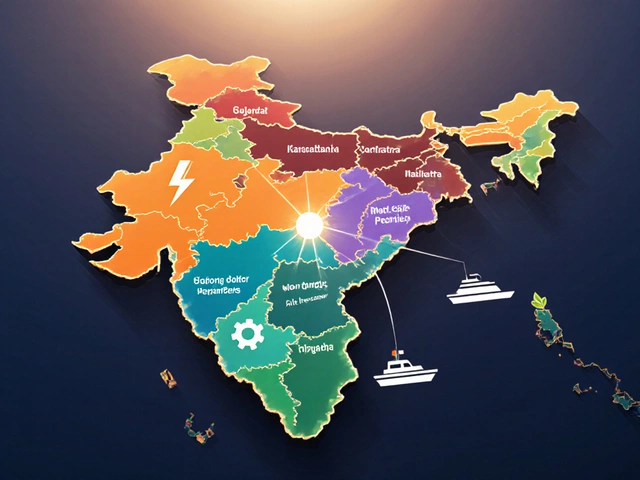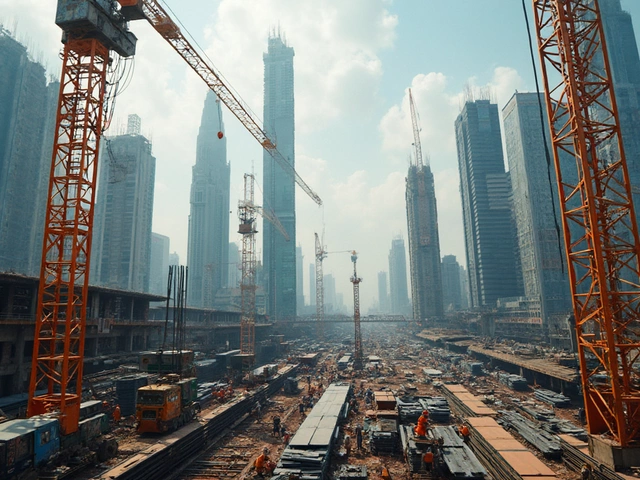India's stepping up its game in the machinery exports scene with some serious force. But what's really rolling off the production lines and finding its way around the globe? Picture this: a bustling factory in the heart of Pune, where machines hum away to create some of the most in-demand agricultural equipment. These machines aren't just any machines; they're India-made, and they're cutting-edge enough to turn heads in international markets.
So, what kinds of machinery are we talking about that countries are eagerly snapping up? Well, to start with, India's been sending out a lot of big-ticket items like power generation gear, construction machines, and automotive parts. These aren't just metal and gears; they're a mark of India's growing expertise and quality benchmarks in manufacturing.
Ever wondered why countries are reaching out to India for their machinery needs? One big reason is cost-effectiveness. The value you get from Indian machinery is like hitting a sweet spot between affordability and quality. Elbowing into markets once dominated by older players, India's offerings are solid on performance and don't break the bank for international buyers.
- The Rise of Indian Machinery Exports
- Key Machinery Categories
- Indian Manufacturing Hubs
- Technology and Innovation
- Export Challenges and Opportunities
- Future Prospects
The Rise of Indian Machinery Exports
India's machinery export scene is buzzing like never before, and it's not just me saying it. In recent years, India's presence in the global market for machinery has jumped by leaps and bounds, turning heads and, of course, generating serious export numbers. A big part of this rise is fueled by the perfect mix of skilled labor, competitive pricing, and a growing reputation for reliable quality.
One key category making waves is industrial machinery. India has been making strides in the production of power generation equipment and machines used in construction and agriculture. Imagine massive earth movers that build roads or these sleek pieces of machinery making crops yield better returns. Developing countries especially are tapping into these resources from India more than ever.
So, what's behind all this growth? The Indian government's initiatives have a lot to do with it. Policies promoting manufacturing, like the 'Make in India' campaign, have provided a robust platform for machinery manufacturers to grow and capture international markets. Tax benefits, relaxed regulations, and investment in infrastructure have given manufacturers a better grip on quality and production efficiency.
And hey, let's not forget innovation. Indian machinery manufacturers have started taking leaps in technology, which is crucial if you want to stand out. Smart manufacturing techniques and an increased focus on research and development mean that India's offerings are not just more of the same—these are fresh and tuned to modern demands.
But hold on, it's not just the manufacturers who are psyched. International buyers are more than happy about sourcing from a burgeoning hub that balances affordability with quality. After all, who wouldn't want high-value for a reasonable cost? Not to mention, it helps that India has strong ties with trading partners in Asia, Africa, and Europe, making it easier to get the goods out efficiently.
To paint a clearer picture, here's a little stat action for you:
| Year | Machinery Export Value (in Billion USD) |
|---|---|
| 2020 | 16.5 |
| 2023 | 21.7 |
These figures are not just numbers; they're a testament to India's rising credibility on the international stage when it comes to machinery exports. Simple as that.
Key Machinery Categories
Alright, so what's in the machinery mix that India’s shipping off by the boatload? Let’s break down the big players.
Agricultural Machinery tops the list with tractors and harvesters. These machines aren't just basic models; they're advanced with smart tech to boost productivity. Farmers around the world find them game-changers, and guess what? Made-in-India tractors are known for their durability and value.
Next up is Construction Equipment. We're talking about bulldozers, excavators, and cranes. Picture big infrastructure projects in Africa or Southeast Asia – there's a good chance Indian machines are doing the heavy lifting. They're not only robust but built to handle diverse terrains and climates, making them a preferred choice for developing regions.
Now, let's not forget Automotive Parts. India isn't just assembling vehicles; it's exporting parts that fit into cars, bikes, and trucks worldwide. These include engines, gearboxes, and more. They're high-quality and precision-made, which is why OEMs (Original Equipment Manufacturers) globally are placing bulk orders.
Then, there’s Power Generation Equipment. With the world pivoting to sustainable energy, India's all about exporting wind turbines and solar panels. And the electrical machinery—like transformers and switchgear—is helping juice up power grids in other countries.
To give you an idea of export trends, here's a quick stat:
| Category | 2024 Export Value (USD Billion) |
|---|---|
| Agricultural Machinery | 2.5 |
| Construction Equipment | 1.8 |
| Automotive Parts | 3.2 |
| Power Generation Equipment | 1.7 |
The strength and versatility in India’s machinery manufacturing keep adding to its reputation as a reliable export partner. So, next time you see heavy machinery up close, there's a decent chance it might just hail from India!
Indian Manufacturing Hubs
When it comes to Indian machinery exports, you'd want to know what's happening on the ground, right? Well, it all boils down to some buzzing hubs that are making waves. Let's take a virtual trip through these hotspots.
First stop, Chennai. This coastal city isn't just about sandy beaches and spicy food. It's a major player in the auto parts and industrial machine scene. Companies here are cranking out parts that keep the wheels turning, literally! No wonder folks around the world are eyeing Chennai's offerings.
Next up, Pune. Nestled in Maharashtra, Pune's got a vibe for all things automotive and engineering. Factories dotting the city specialize in everything from tractors to heavy machinery. If you've ever wondered where power-packed agricultural machines come to life, Pune's your answer.
And don't skip out on Bengaluru. Known as the Silicon Valley of India, it’s a tech wonderland. But it's not just about software. Bengaluru's engineers are also crafting some futuristic industrial equipment, making it a hub for innovation and technology.
Let's not forget Ahmedabad. This city's not only about Gujarati thalis. Manufacturers there are producing a mix of textiles, apparel machinery, and also getting into the big league with heavy machines.
Finally, there's Coimbatore, lovingly called the 'Manchester of South India.' This city is all about textile machinery, and they're really stitching up a storm globally. Not just that, but the city's small and medium manufacturers are setting benchmarks in quality and affordability.
What makes these hubs work so well is a mix of skilled labor, decent infrastructure, and a nose for market trends. This keeps India's machinery manufacturers nimble and competitive on the global stage. Wherever you look, chances are a key machine part has roots in one of these vibrant hubs.

Technology and Innovation
India isn't just keeping up with global machinery trends—it's setting them. The secret sauce? Continuous innovation paired with cutting-edge technology. Indian manufacturers are diving headfirst into integrating smart tech into their machines. It's not uncommon to see machinery fitted with IoT (Internet of Things) devices that allow remote monitoring and management.
This kind of tech isn't just for show. Imagine being able to tweak the settings of a power generator from a cozy office thousands of miles away—pretty cool, right? It's the kind of innovation that's making Indian machinery exports a hot commodity worldwide. Customers are digging the fact that they can boost efficiency and reduce downtime with these smart features.
An example? Think of Pune's industrial belts where 3D printing tech is now a norm, not an exception. By leveraging 3D printing, manufacturers can rapidly prototype and then tweak designs with instant feedback. This is a game-changer for machinery manufacturers in India, allowing them to meet custom client needs without dragging timelines.
- Integration of automation in manufacturing processes to reduce human error.
- Use of AI-driven diagnostics to preemptively identify potential machinery failures.
- Implementation of eco-friendly solutions to meet global environmental standards.
Here’s a nugget to chew on: a recent study found that about 60% of Indian manufacturing units that adopt advanced technologies saw a 25% boost in productivity. That's a lot of bang for the buck and is part of why international buyers are flocking to Indian options.
Of course, it's not all smooth sailing. Challenges like upskilling workers to handle these new tech advancements remain. But with government push towards Digital India and collaboration with tech giants, the loom of progress is weaving something impressive indeed.
Export Challenges and Opportunities
Alright, diving into why India's machinery exports are buzzing, but also what's holding them back a bit. First, let's talk about the hurdles. One common snag for Indian machinery exports is the high tariffs and trade barriers they face in some countries. Yep, these can be real roadblocks, making Indian goods pricier abroad.
Then there's the whole logistics and infrastructure side of it. For a country as big and densely populated as India, getting machinery from manufacturing hubs to ports efficiently isn't always straightforward. The roads can be challenging, and ports at times are overwhelmed with volume, affecting turnaround times.
But hey, it's not all uphill battles. There are some golden opportunities shining too. One biggie is the growing demand for eco-friendly and sustainable machinery. As global awareness about the environment rises, Indian manufacturers are stepping up, producing more energy-efficient machines. This not only meets international standards but is also friendly to Mother Earth.
Also, there's a massive tech-driven transformation happening. India's jumping on this tech bandwagon, integrating more IoT (Internet of Things) solutions into their machinery. Smart machines that can offer real-time data to users are becoming a hot commodity.
And boom, we have the new trade agreements. With fresh ties and stronger bonds forming with countries in Africa and Southeast Asia, there's a ton of potential for growth in these markets. Indian machinery is finding fresh ground where demand is high but supply is limited.
If you look at the numbers, India's machinery exports have been growing at a healthy pace, showing a significant year-on-year increase in several categories:
| Category | Growth Rate (2024) |
|---|---|
| Industrial Machinery | 12% |
| Agricultural Equipment | 15% |
| Construction Machinery | 9% |
So, while there are obstacles to tackle, there's also a gold mine of opportunities waiting. It's a bumpy ride for sure, but with the right moves, Indian machinery exports could definitely go the extra mile in the coming years.
Future Prospects
Looking ahead, India's trajectory in the machinery export world looks pretty exciting. The global demand for Indian-made equipment is set to rise, driven by ongoing improvements in technology and increasing trust in India's manufacturing capabilities. So, what’s on the horizon for India’s machinery exporters?
First off, expect to see a significant boom in the export of eco-friendly machinery. With climate change concerns becoming front and center, countries are seeking sustainable solutions, and India is investing heavily in producing greener technology. This shift to sustainability could position India as a leader in environmentally-conscious machinery production.
Another key player on the scene is automation. As factories worldwide pivot towards more automated processes, India's been quick to jump on the bandwagon. The production of robotics and sophisticated automated machinery has seen major development, promising an export boom in these high-tech categories.
Then there’s the expanding market for smart agricultural equipment. As global food demands grow, efficient farming technology is crucial. India’s innovations in this area promise cheaper and smarter agricultural solutions poised to take the world by storm.
Despite all these opportunities, it’s not all smooth sailing. Challenges like evolving safety standards and stricter international compliance rules are hurdles Indian manufacturers are gearing up to tackle. But with strategic planning and leverage from the government’s “Make in India” initiative, overcoming these won't just be a dream.
Let’s not forget the game-changing impact of digital platforms in connecting Indian manufacturers with international buyers. Efforts to enhance online presence and streamline logistics are reshaping how India’s machinery exports are managed and marketed globally.
Navigating these prospects with a tide of innovation and a commitment to quality is crucial for India to cement its position as a machinery manufacturing powerhouse on the global stage.






